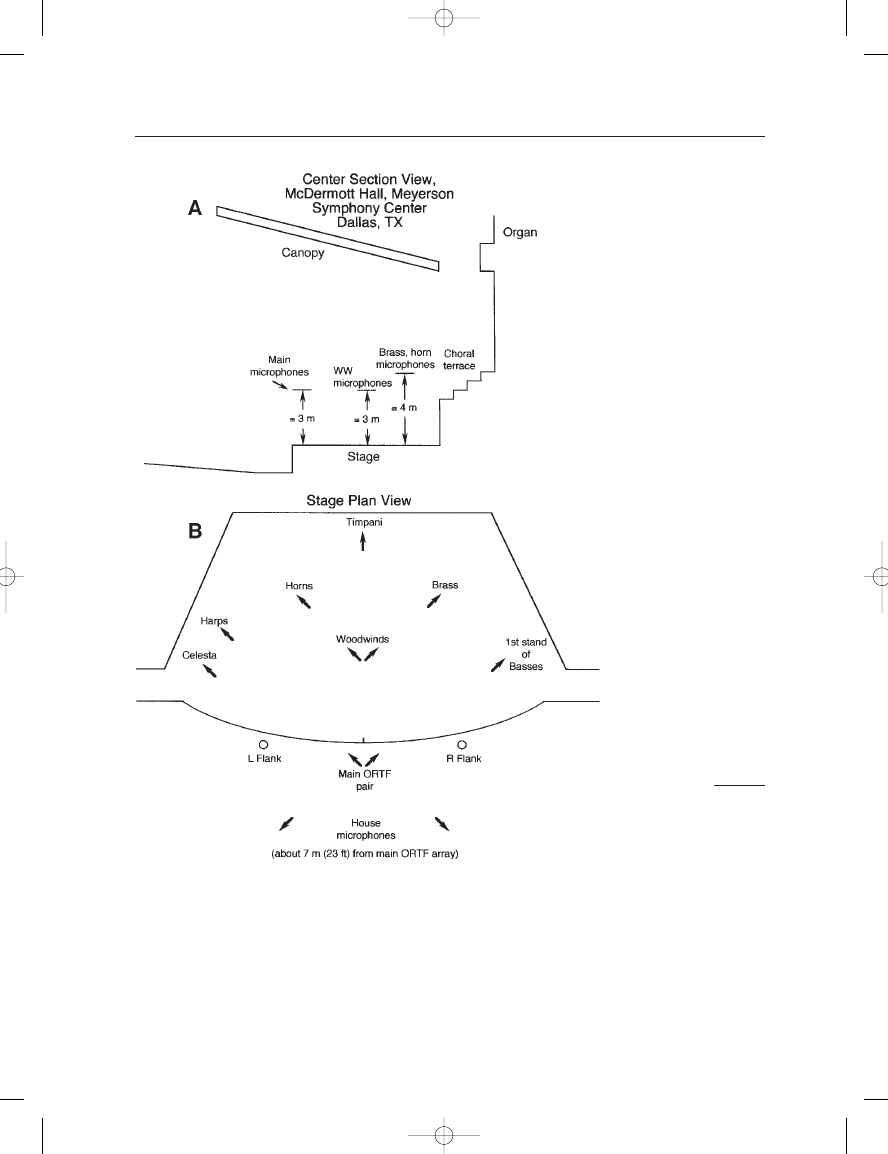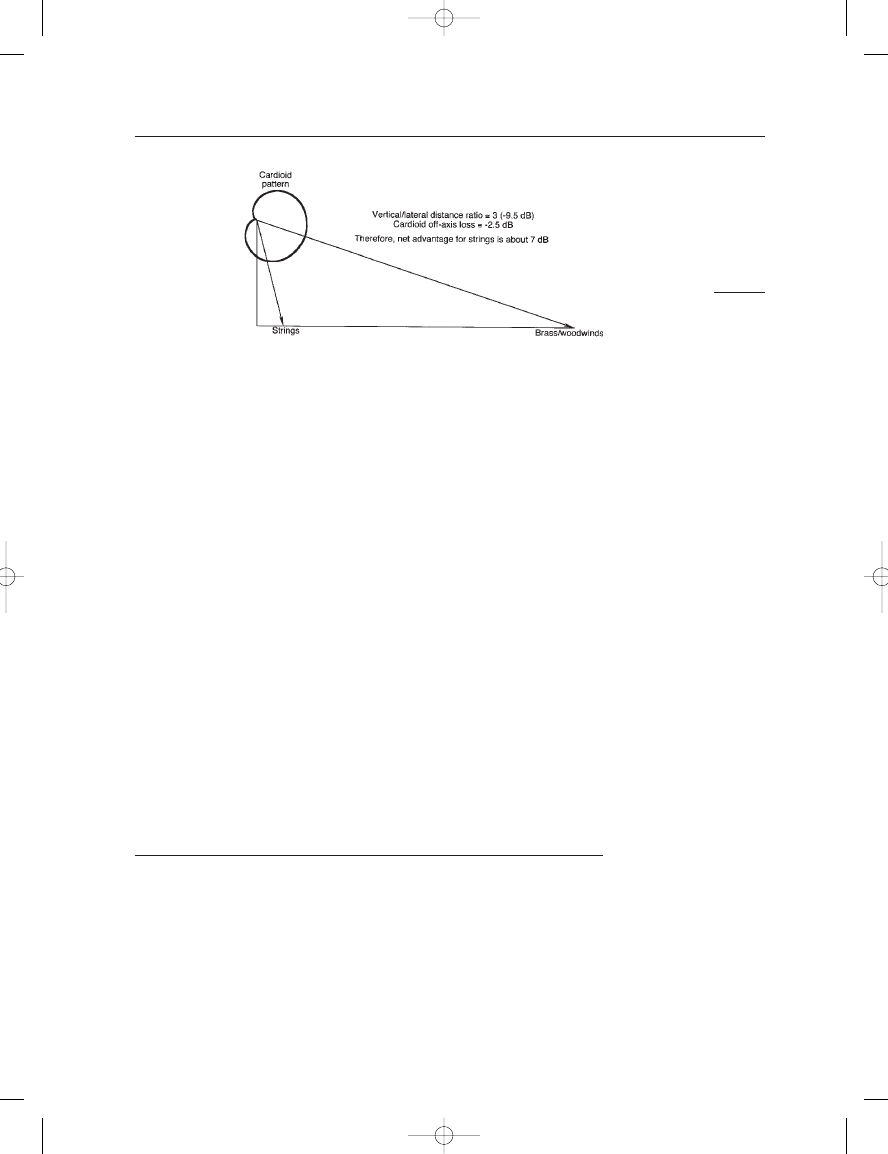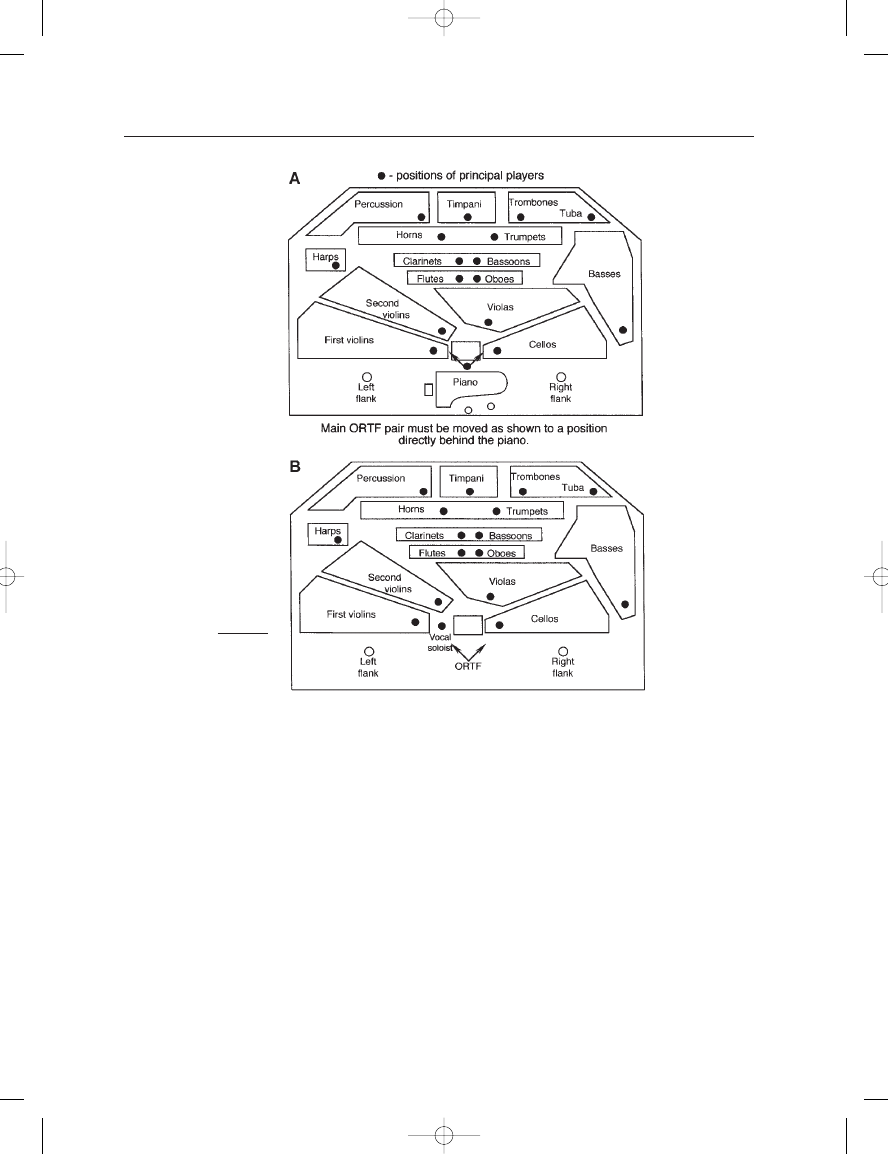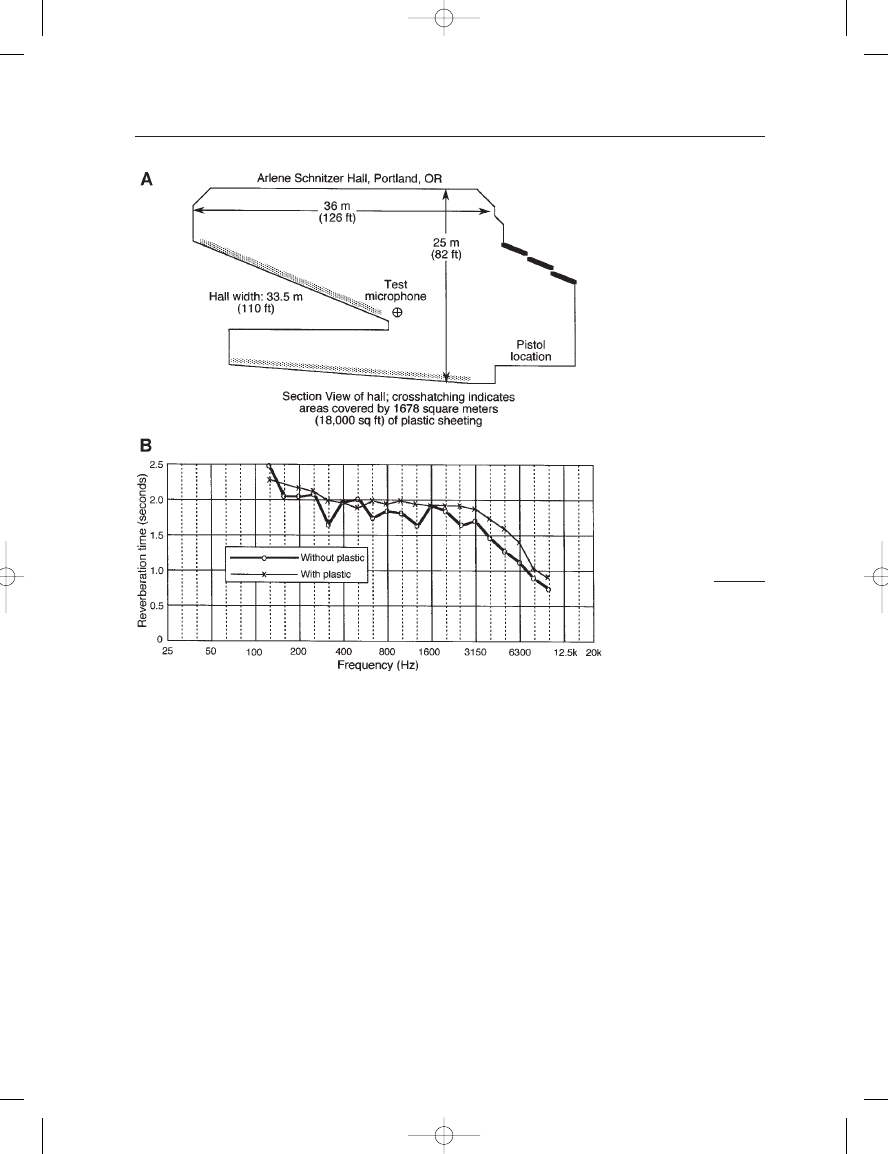ВУЗ: Казахская Национальная Академия Искусств им. Т. Жургенова
Категория: Книга
Дисциплина: Не указана
Добавлен: 03.02.2019
Просмотров: 17301
Скачиваний: 51

THE MICROPHONE BOOK
208
FIGURE 13–13
Dallas Symphony
Orchestra, recording
Holst’s The Planets: Side
view (A); plan view (B).
All accent microphones were operated with a slight LF rolloff below
about 100 Hz. With the exception of the house pair, they were all fed in
varying amounts to a digital reverberation unit whose parameters were
set to match those of the occupied hall. The stereo output of the rever-
beration unit was returned to the two-channel stereo mix at an appro-
priate level – no more than to ensure that the effect of the accent
microphones blended with the natural pickup provided by the main four
Earg_13.qxd 14/9/04 2:53 PM Page 208

microphones across the front of the orchestra. An off-stage chorus was
located in the stage house behind the orchestra and the sound was intro-
duced into the hall via the stage doors. No additional microphones were
used here.
The choice of instruments and sections to be given preference with
accent microphones was made in consultation with the recording pro-
ducer, taking into account overall musical requirements of the score.
While the main microphones were virtually fixed in level, the individual
accent microphones were adjusted on a running basis by no more than
about
2.5 dB, according to musical requirements. (See Compact Disc
Reference 8.)
SOME VARIATIONS ON THE LARGE ORCHESTRA SETUP
In many modern concert halls a large chorus may be placed in a choral
terrace behind the orchestra, calling for an additional stereo pair of
microphones. In many older halls, the orchestra is moved forward and
the chorus placed on risers positioned behind the back row of orchestra
players. If the hall is of the proscenium type, the chorus often finds itself
in the very dead up-stage acoustical setting, calling for its own micro-
phones (two or three in stereo) along with the correct amount of artifi-
cial reverberation to match them with the normal orchestra pickup.
A recurring problem with recording works for chorus and orchestra
is leakage of the back of the orchestra (brass and percussion) into the
choral microphones. This can be alleviated by elevating the choral micro-
phones as high as is practicable by overhead rigging.
If there is no audience present, an excellent alternative is to place the
chorus in the house behind the conductor and picking it up with its own
dedicated stereo microphone array. The effect is excellent in that the
chorus has immediate acoustical contact with the hall.
COMMENT ON FRONT–BACK COVERAGE OF THE ORCHESTRA
The main and woodwind ORTF microphone pairs are aimed downward
in order to adjust front–back balances in their respective pickup patterns.
This procedure is detailed in Figure 13–14.
The directional patterns are of course cardioid, and the idea here is
to trade off the balance of the nearer instruments with those toward the
rear by taking advantage of the off-axis attenuation of the microphones’
patterns. Considering the main ORTF pair, as shown in Figure 13–14, the
elevation angle has been set so that the primary axis of the microphones
is aimed at the woodwinds, brass and horns. When this is done, the off-
axis pattern attenuation of the frontal strings will be about
2.5 dB.
However, the front of the orchestra is about one-third the distance from
the microphones relative to the more distant woodwinds, brass and
horns. The net pickup difference will then be 9.5
2.5, or about 7 dB,
favoring the front of the orchestra. We must remember however that both
woodwinds and brass instruments are essentially forward facing with
13: Classical Stereo Recording Techniques and Practice
209
Earg_13.qxd 14/9/04 2:53 PM Page 209

directivity indices that are in the range of 4 or 5 dB. Thus, with their
direct sound virtually aimed at the frontal microphones, the front–back
orchestra balance will generally seem quite natural. In some cases both
engineer and producer may wish to emphasize the strings even more by
lowering the elevation angle to favor the strings to a greater degree.
SOLOISTS WITH ORCHESTRA
In a concert setting the addition of a piano for concerto use will require
that the center-front orchestral players move upstage as needed so that the
piano may be placed between the conductor and the house, as shown in
Figure 13–15A. If an audience is present, this repositioning often inter-
feres with the placement of the main microphone pair. Ideally, it should
be just in front of the piano, but considerations of sightlines may force the
engineer to place the microphone stand just behind the instrument. With
hanging microphones there is no problem here at all; the main pair can
be placed in its ideal position. (See Compact Disc Reference 9.)
Vocal or string soloists are often placed to the conductor’s left and
will not interfere with the main microphone setup. Whenever possible,
these soloists should be picked up with a coincident or near-coincident
stereo pair, as opposed to a single microphone. The intent here is to pre-
serve natural stereo perspectives in case the engineer has to increase the
level of the soloist’s microphones during very soft passages. Details are
shown in Figure 13–15B. (See Compact Disc Reference 10.)
LIVENING OR DEADENING THE PERFORMANCE SPACE
A hall that is too live can be easily deadened by placing velour material
at strategic points in the performance space. Where possible, the velour
should be hung over balcony railings or freely hung away from the walls
as banners. A little will often go a long way, and it is highly recom-
mended that an acoustical consultant be engaged to oversee this tempo-
rary modification.
It is a bit more complicated to liven a space, but the technique detailed
in Figure 13–16 produces surprising results. Before and after examples are
THE MICROPHONE BOOK
210
FIGURE 13–14
Downward elevation of
main ORTF microphones.
Earg_13.qxd 14/9/04 2:53 PM Page 210

given in Compact Disc Reference 11. The effect of the 0.004 in. (0.1 mm)
thick vinyl material is to reflect high frequencies arriving at a fairly low
grazing angle of incidence. It does not have to be stretched in any manner;
rather, simply laid over the seating area. (The vinyl material in question is
available at building supply stores under a number of trade names. No
material less than 0.004 in. thickness should be used.)
As we have mentioned before, artificial reverberation on accent
microphones is an accepted practice in current classical recording; how-
ever, there is no substitute for natural reverberation to enhance the pri-
mary pickup via the main microphones and house microphones.
HOW MUCH REVERBERATION IS NEEDED IN THE RECORDING?
Music of different periods will require varying amounts of reverberation,
both in level and in decay time. General recommendations for concert
venues, as a function of room volume and music type, are given in
13: Classical Stereo Recording Techniques and Practice
211
FIGURE 13–15
Recording soloists with
orchestra. Piano (A);
vocalist (B).
Earg_13.qxd 14/9/04 2:53 PM Page 211

Figure 13–17. In general, reverberation times exceeding about 2.5 seconds
will sound rather unnatural on orchestral musical, whatever the period.
Both classical and modern era music fare best with reverberation times on
the order of 1.5 s, while romantic compositions may do with reverberation
times up to 2 s. While ecclesiastical music is often heard in large spaces
with up to 4 or 5 s of reverberation time, in recording it is probably better
to err on the short side in order to keep the reverberation from interfering
with musical details.
Kuhl (1954) developed the data shown in Figure 13–18. Here, mono-
phonic recordings were played for a listening panel whose individual pref-
erences for reverberation time are plotted. The median points are taken
as target values. We need to add that these tests, if repeated today in
stereo, could result in slightly longer target reverberation time values, due
to the ability of stereo listening to delineate direct-to-reverberant details
more accurately than in mono listening. In any event, the tendencies
shown here are certainly relevant in today’s recording activities.
THE MICROPHONE BOOK
212
FIGURE 13–16
Livening the recording
venue: section view (A);
measured reverberation
time with and without
plastic material (B).
Earg_13.qxd 14/9/04 2:53 PM Page 212